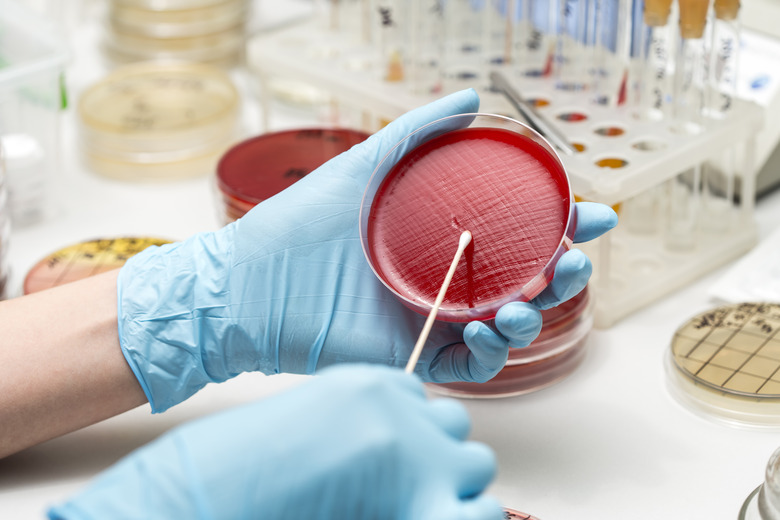How To Identify An Unknown Bacteria In Microbiology
Begin the process of identifying unknown bacteria by observing their physical characteristics, such as cell wall, shape and linkages. Use standard laboratory procedures, like cell staining, culturing and DNA sequencing to further narrow down your identification. Bacteria are generally grouped into species according to their physical and metabolic characteristics, rather than their genetic relationships to one another.
Positive or Negative
Positive or Negative
Eubacteria are the so-called true bacteria. They're distinct from archaea or archaebacteria, which form a separate kingdom. Eubacteria are prokaryotes, which means they lack a nuclear membrane. Most have cell membranes and cell walls. Bacteria with thick cells walls are termed gram-positive because they're susceptible to dying during a test called the Gram stain. The Gram stain is the first test used in bacterial classification. Bacteria with thin or absent cells walls are gram-negative because they do not trap the Gram stain dye.
Shaping Up Bacteria
Shaping Up Bacteria
Spherical bacteria are termed cocci, bacteria that form straight rods are called bacilli and bacteria with an intermediate shape are called coccobacilli. These can all be gram-negative or gram-positive. Rigid, spiral-shaped bacteria are known as spirilla and are only gram-negative. Flexible, independently mobile, spiral-shaped bacteria are called spirochetes and are gram-neutral. Finally, rigid, comma-shaped rods are called vibrios and are gram-negative. A few little-known and poorly understood bacteria have different shapes, such as the star-shaped stella and axe-shaped labrys. There are also two intermediate bacterial groups. Rickettsia are similar to viruses, have a variety of shapes, are gram-negative and can only survive inside other cells. Mycoplasma, which are similar to fungi, lack cell walls and include many species-specific, pneumonia-causing lung pathogens.
Cubes, Clusters, and Other Linkages
Cubes, Clusters, and Other Linkages
Cocci and bacilli are further classified by the linkages they form after cell division. Diplococci and diplobacilli stick together in pairs. Streptococci and streptobacilli form chains. Tetrad cocci stay in squares of four bacteria. Sarcinae cocci form eight-bacteria cubes and staphylococci form clusters.
Identifying the Bacterium
Identifying the Bacterium
If you have an unknown bacteria and you want to identify it, you'll typically perform a gram stain and then observe the colony appearance and the individual features. At that point, you can say you have, for example, a gram-negative, aerobic streptobacilli. You can then compare your sample to various known bacteria by placing it on different culture media that encourage the growth of some species and inhibit others, or by testing the sample for different known bacterial byproducts. As a final resort, DNA sequencing can determine if you have a known or unknown bacterial species or strain, provided you're comparing it to a species or strain whose genome has already been sequenced.
References
- Mountain Empire Community College: Bacterial Shapes and Classification
- Types of Bacteria: How Many Types of Bacteria Are There?
- Mountain Empire Community College: Types of Bacteria
- Medscape: Rickettsial Infection
- Todar's Online Textbook of Bacteriology: Bacterial Pathogens of Humans
- Todar's Online Textbook of Bacteriology: Borellia burgdorferi and Lyme Disease
- University of South Carolina School of Medicine: Enterobacteriaceae, Vibrio, Campylobacter and Helicobacter
Cite This Article
MLA
Libal, Angela. "How To Identify An Unknown Bacteria In Microbiology" sciencing.com, https://www.sciencing.com/identify-unknown-bacteria-microbiology-8502065/. 9 March 2018.
APA
Libal, Angela. (2018, March 9). How To Identify An Unknown Bacteria In Microbiology. sciencing.com. Retrieved from https://www.sciencing.com/identify-unknown-bacteria-microbiology-8502065/
Chicago
Libal, Angela. How To Identify An Unknown Bacteria In Microbiology last modified August 30, 2022. https://www.sciencing.com/identify-unknown-bacteria-microbiology-8502065/
